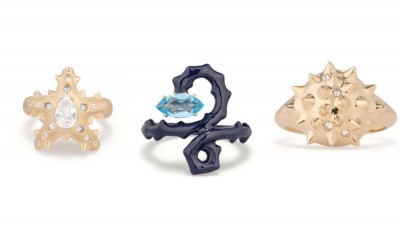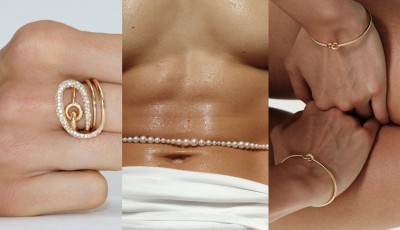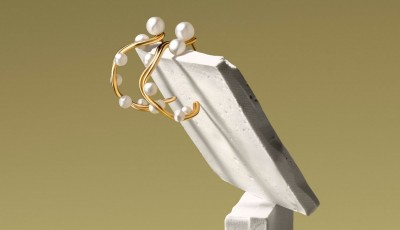Diamonds Against Downturns
Ilan Kaplan, Isparkle Ceo, explains why coloured and rare diamonds are more and more a unique investment opportunity
According to Forbes, the super rich are significantly richer than they were when the pandemic hit the markets last March, with 25 people on its billionaire list now a combined $255 billion richer than they were 2 months ago. The company iSparkle, which specialises in large, rare and coloured diamonds, has been seeing significantly increased demand for investment diamonds from its high net worth clients and from family wealth managers in the US, Asia and Europe. It only works with super rare diamonds as investment items. Not every diamond is a good investment. On the contrary, very, very few diamonds fall into this category and at iSparkle, we focus on rare coloured diamonds in different categories of pinks, blues and yellows. Many people are now asking for advice on how they can efficiently invest in very high value coloured diamonds for the long term. In 2008 Argyle Pink diamonds increased by 30% while the S&P lost 38% of its value. Pink and red diamonds have increased in value by 400% over the last 18 years, according to Argyle owners Rio Tinto. Also the Argyle mine, the source of the world’s most prized, and expensive, pink diamonds, is due to close this year. From 2010 to 2019, pink, blue and yellow diamonds increased 77% in value, with pink increasing by 116%, blue by 81% and yellow by 21% according to the Fancy Color Research Foundation.
We discussed about this topic with Isparkle Ceo, Ilan Kaplan, former chairman of the South African Diamond Manufacturers Association.
Mr Kaplan, who is looking for this kind of diamonds?
At iSparkle, we specialise in diamonds that are 3 carats and larger and in rare, coloured diamonds. iSparkle serves several different audiences – we have an array of clients throughout the world comprised of both diamond dealers and retail jewelers. But it’s our department for investment diamonds that is seeing an increase in demand currently. I find the performance of investment diamonds particularly fascinating because I’m a chartered financial analyst as well having a career rooted in the African diamond industry having been a former chairman of the South African Diamond Manufacturers Association while I’ve specialised in large natural diamonds for over 15 years. Through our investment arm at iSparkle, we assist and advise high net worth individuals and families and asset managers, in purchasing top end investment grade diamonds as an alternate asset class. Our investment clients are global, often from the US, Asia and Europe, but ultimately there’s a real mix in geographical locations. Investors like these might have multiple homes and be owners of businesses with bases in multiple locations so it’s very often people with an international mindset and a head for the long-term view, for both diamonds and the financial future of their families.
How much would your clients pay for a diamond, and what kind of diamonds are they looking for?
iSparkle only works with super rare diamonds as investment items. Not every diamond is a good investment. On the contrary, very, very few diamonds fall into this category and at iSparkle, we focus on rare coloured diamonds in different categories of pinks, blues and yellows. Our investor clients might spend anything from $100,000 for a carefully considered diamond investment but for the most confident investors who have long viewed diamonds as an alternative investment and who have the means, they know as much as we do that the sky really is the limit. Why else would Chinese jewelry giant Chow Tai Fook have paid a record-breaking $71.2m for the 59.6 carat Pink Star (the highest price ever paid for a diamond at auction) at Sotheby’s in 2017? Or a rich buyer pay a world-record breaking $4.2m a carat for the 12.03 carat Blue Moon of Josephine (the highest price ever paid per carat for a diamond at auction) at Sotheby’s Geneva in 2015?
Why are the super rich seeing diamonds as a safe haven investment?
Diamonds have long been used by the super rich to safeguard against major downturns in macro-economic activity because they have proved themselves immune to huge shocks in the financial markets thanks to their extraordinarily inherent rarity. During the last few months, the rich have become richer. Forbes recently reported that 25 of the world's wealthiest people on the Forbes billionaire list are worth $255 billion more than when the pandemic hit the stock market in March. Amazon owner Jeff Bezos is now a staggering $30bn richer. I believe that just as in the past, rare and exquisite investment diamonds will be more resilient to the current Covid-19 pandemic. By virtue of the fact that these natural resources are so rare and so sought after, their value would be immune to short to medium-term ripples in the world financial markets and diamond markets. The value of these items is not determined by simple economic supply and demand fundamentals but rather by the inherent value of such a rare natural resource. The current crisis presents a unique investment opportunity in these items. Investors are looking for alternate asset classes which will deliver capital growth over time as every single other conventional asset class is subject to instability. In 2008 Argyle Pink diamonds increased by 30% while the S&P lost 38% of its value. Pink and red diamonds have increased in value by 400% over the last 18 years, according to Argyle owners Rio Tinto. Also bear in mind that the Argyle mine, the source of the world’s most prized, and expensive, pink diamonds, is due to close this year. From 2010 to 2019, pink, blue and yellow diamonds increased 77% in value, with pink increasing by 116%, blue by 81% and yellow by 21% according to the Fancy Color Research Foundation. Sotheby's recently broke online auction records, earning $100m to date in 2020, which is 37% up on last year. Sotheby's jewellery sale on 7 April broke the record for any online jewellery sale reaping $3.7m. Meanwhile, a Cartier diamond bracelet sold by Sotheby's fetched $1.3m on 28 April, the highest price paid for a piece of jewellery in an online sale and the most expensive auctioned jewel so far in 2020. It’s also worth mentioning that owning the right diamond for you is the most fun you’re ever likely to have with any asset class.
What is the main difference with gold?
Gold is completely commoditised. It is standardised and has a standardised price. By virtue of the fact that gold is traded on an exchange, its price is easily impacted by the movement of other asset classes. The price of gold is simply a function of supply and demand. It moves up and down. The super rare items which we recommend to our clients as investment diamonds are so special that there are no two the same. They are not commoditised and are not correlated to any other asset class. They are so specialised that their price simply increases over time. We always see an uptick in demand in times of crisis as the advantages of such an investment are more apparent in these times. I constantly advise our clients not to wait for times of crisis to make such an investment. I am not proposing diamonds as a substitute for any other asset class but rather as an additional component to any investment portfolio.
Pre and post Covid. Differences and analogies in approaching the diamond market?
There have been significant changes in diamond and jewelry buying behaviours since the start of the pandemic. Of course, foot traffic through traditional jewelry and diamond stores came to a grinding halt in many cases as thousands of jewelry stores shut their doors and operated exclusively online, although it is likely in-store traffic will pick up in the coming months as malls and shops start to re-open. At the same time, the average price of online purchases is very much on the up as an increasing amount of business is conducted from home. We’ve seen significant online purchases from the super rich as well as purchases by people wanting to mark special occasions and revel in the feel-good factor generated by a milestone diamond jewellery purchase.
Top tips for diamond investors?
It is crucially important to get the correct advice. A proper needs analysis needs to be done for every client so as to recommend the correct fit for each and every client. It’s important to remember that the vast majority of diamonds will not perform well as investments. At iSparkle we have the unique combination of both deep financial and diamond market knowledge and so we are very well equipped to service our clients. There are lessons we can learn from previous recessions. Towards the end of 2008 we found ourselves in a similar position. Luxury retail had been hit very hard and trading paused in the polished diamond markets. But in 2009 and into 2010 polished diamond prices came back very quickly. I am cautiously optimistic that once the virus is beaten, and we will beat it, people will be back on the streets and in the stores and that demand for diamonds and diamond jewellery will have a big boost. I would like to encourage people to never waste a good crisis. I believe that in times of adversity there is opportunity. I believe that now is the perfect time to make significant investment in rare and exquisite investment diamonds. These rare items have proven their resilience over time.
We discussed about this topic with Isparkle Ceo, Ilan Kaplan, former chairman of the South African Diamond Manufacturers Association.
Mr Kaplan, who is looking for this kind of diamonds?
At iSparkle, we specialise in diamonds that are 3 carats and larger and in rare, coloured diamonds. iSparkle serves several different audiences – we have an array of clients throughout the world comprised of both diamond dealers and retail jewelers. But it’s our department for investment diamonds that is seeing an increase in demand currently. I find the performance of investment diamonds particularly fascinating because I’m a chartered financial analyst as well having a career rooted in the African diamond industry having been a former chairman of the South African Diamond Manufacturers Association while I’ve specialised in large natural diamonds for over 15 years. Through our investment arm at iSparkle, we assist and advise high net worth individuals and families and asset managers, in purchasing top end investment grade diamonds as an alternate asset class. Our investment clients are global, often from the US, Asia and Europe, but ultimately there’s a real mix in geographical locations. Investors like these might have multiple homes and be owners of businesses with bases in multiple locations so it’s very often people with an international mindset and a head for the long-term view, for both diamonds and the financial future of their families.
How much would your clients pay for a diamond, and what kind of diamonds are they looking for?
iSparkle only works with super rare diamonds as investment items. Not every diamond is a good investment. On the contrary, very, very few diamonds fall into this category and at iSparkle, we focus on rare coloured diamonds in different categories of pinks, blues and yellows. Our investor clients might spend anything from $100,000 for a carefully considered diamond investment but for the most confident investors who have long viewed diamonds as an alternative investment and who have the means, they know as much as we do that the sky really is the limit. Why else would Chinese jewelry giant Chow Tai Fook have paid a record-breaking $71.2m for the 59.6 carat Pink Star (the highest price ever paid for a diamond at auction) at Sotheby’s in 2017? Or a rich buyer pay a world-record breaking $4.2m a carat for the 12.03 carat Blue Moon of Josephine (the highest price ever paid per carat for a diamond at auction) at Sotheby’s Geneva in 2015?
Why are the super rich seeing diamonds as a safe haven investment?
Diamonds have long been used by the super rich to safeguard against major downturns in macro-economic activity because they have proved themselves immune to huge shocks in the financial markets thanks to their extraordinarily inherent rarity. During the last few months, the rich have become richer. Forbes recently reported that 25 of the world's wealthiest people on the Forbes billionaire list are worth $255 billion more than when the pandemic hit the stock market in March. Amazon owner Jeff Bezos is now a staggering $30bn richer. I believe that just as in the past, rare and exquisite investment diamonds will be more resilient to the current Covid-19 pandemic. By virtue of the fact that these natural resources are so rare and so sought after, their value would be immune to short to medium-term ripples in the world financial markets and diamond markets. The value of these items is not determined by simple economic supply and demand fundamentals but rather by the inherent value of such a rare natural resource. The current crisis presents a unique investment opportunity in these items. Investors are looking for alternate asset classes which will deliver capital growth over time as every single other conventional asset class is subject to instability. In 2008 Argyle Pink diamonds increased by 30% while the S&P lost 38% of its value. Pink and red diamonds have increased in value by 400% over the last 18 years, according to Argyle owners Rio Tinto. Also bear in mind that the Argyle mine, the source of the world’s most prized, and expensive, pink diamonds, is due to close this year. From 2010 to 2019, pink, blue and yellow diamonds increased 77% in value, with pink increasing by 116%, blue by 81% and yellow by 21% according to the Fancy Color Research Foundation. Sotheby's recently broke online auction records, earning $100m to date in 2020, which is 37% up on last year. Sotheby's jewellery sale on 7 April broke the record for any online jewellery sale reaping $3.7m. Meanwhile, a Cartier diamond bracelet sold by Sotheby's fetched $1.3m on 28 April, the highest price paid for a piece of jewellery in an online sale and the most expensive auctioned jewel so far in 2020. It’s also worth mentioning that owning the right diamond for you is the most fun you’re ever likely to have with any asset class.
What is the main difference with gold?
Gold is completely commoditised. It is standardised and has a standardised price. By virtue of the fact that gold is traded on an exchange, its price is easily impacted by the movement of other asset classes. The price of gold is simply a function of supply and demand. It moves up and down. The super rare items which we recommend to our clients as investment diamonds are so special that there are no two the same. They are not commoditised and are not correlated to any other asset class. They are so specialised that their price simply increases over time. We always see an uptick in demand in times of crisis as the advantages of such an investment are more apparent in these times. I constantly advise our clients not to wait for times of crisis to make such an investment. I am not proposing diamonds as a substitute for any other asset class but rather as an additional component to any investment portfolio.
Pre and post Covid. Differences and analogies in approaching the diamond market?
There have been significant changes in diamond and jewelry buying behaviours since the start of the pandemic. Of course, foot traffic through traditional jewelry and diamond stores came to a grinding halt in many cases as thousands of jewelry stores shut their doors and operated exclusively online, although it is likely in-store traffic will pick up in the coming months as malls and shops start to re-open. At the same time, the average price of online purchases is very much on the up as an increasing amount of business is conducted from home. We’ve seen significant online purchases from the super rich as well as purchases by people wanting to mark special occasions and revel in the feel-good factor generated by a milestone diamond jewellery purchase.
Top tips for diamond investors?
It is crucially important to get the correct advice. A proper needs analysis needs to be done for every client so as to recommend the correct fit for each and every client. It’s important to remember that the vast majority of diamonds will not perform well as investments. At iSparkle we have the unique combination of both deep financial and diamond market knowledge and so we are very well equipped to service our clients. There are lessons we can learn from previous recessions. Towards the end of 2008 we found ourselves in a similar position. Luxury retail had been hit very hard and trading paused in the polished diamond markets. But in 2009 and into 2010 polished diamond prices came back very quickly. I am cautiously optimistic that once the virus is beaten, and we will beat it, people will be back on the streets and in the stores and that demand for diamonds and diamond jewellery will have a big boost. I would like to encourage people to never waste a good crisis. I believe that in times of adversity there is opportunity. I believe that now is the perfect time to make significant investment in rare and exquisite investment diamonds. These rare items have proven their resilience over time.







